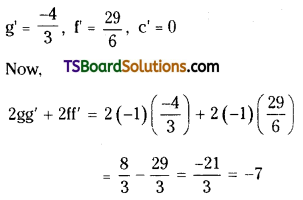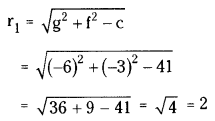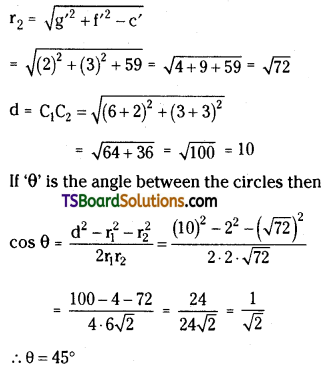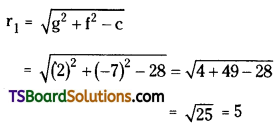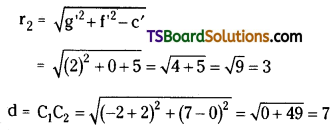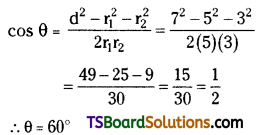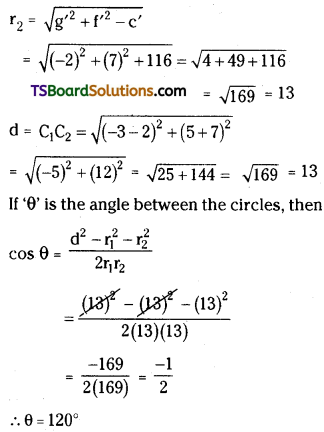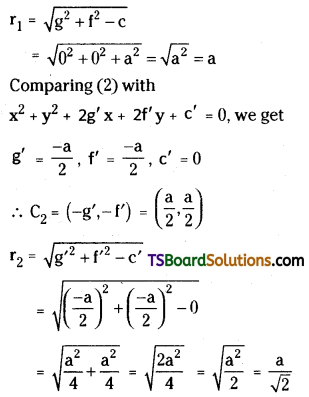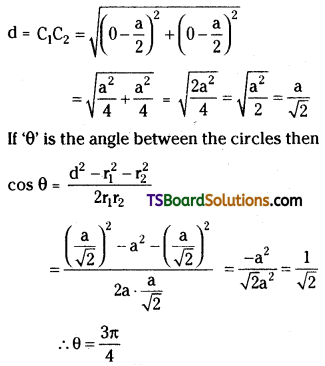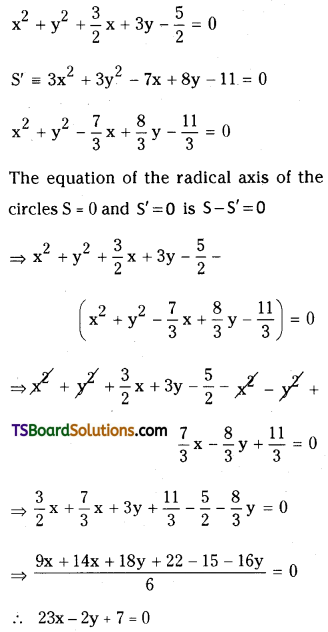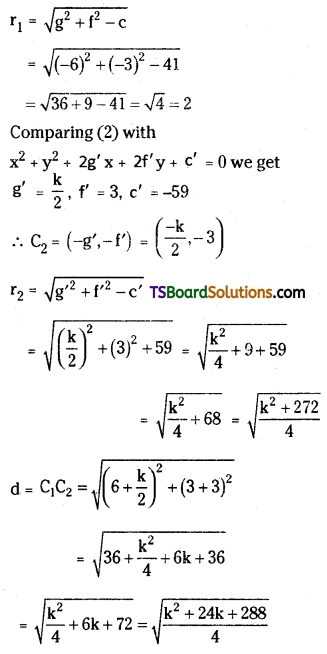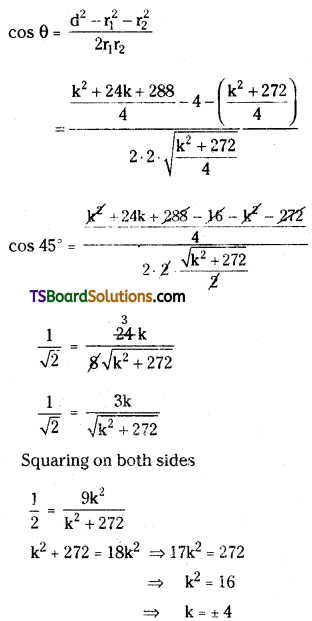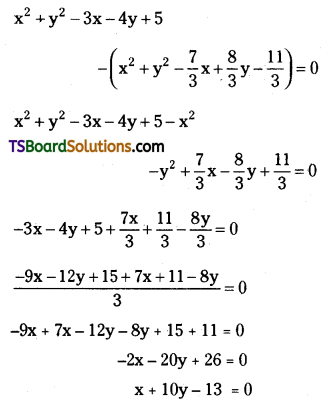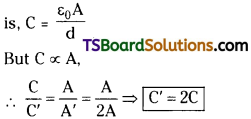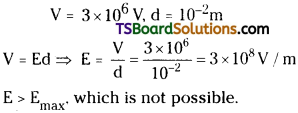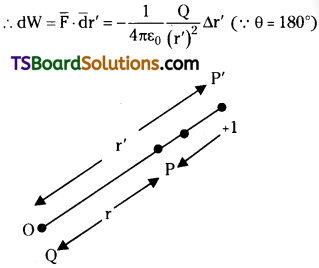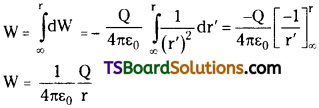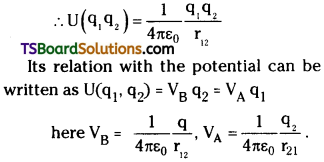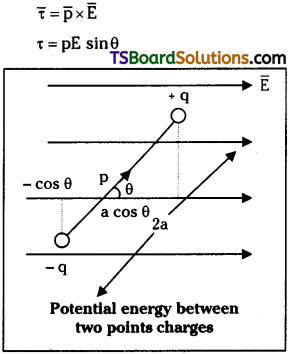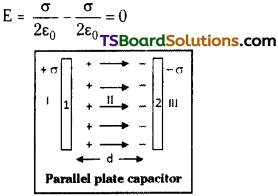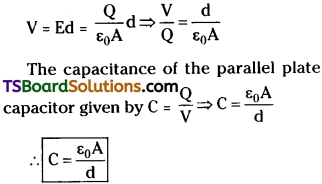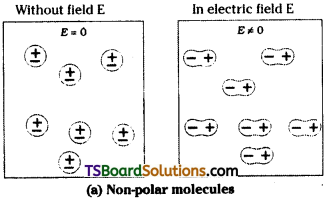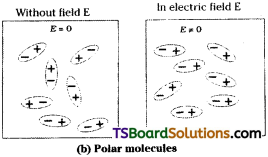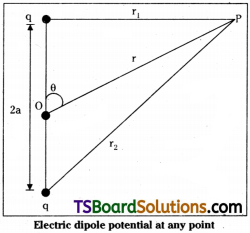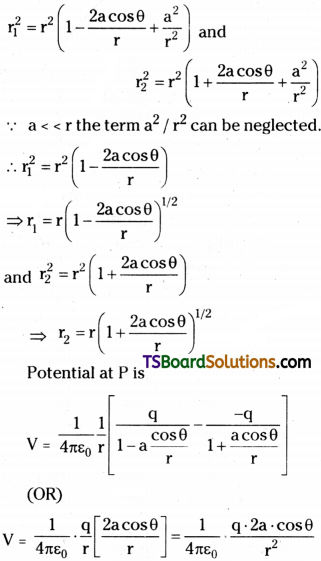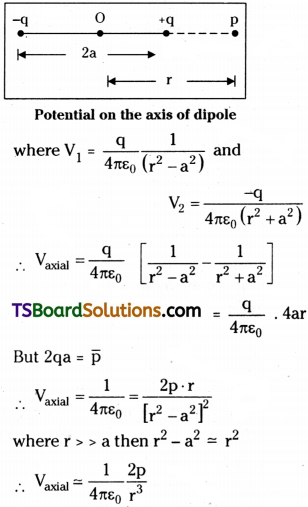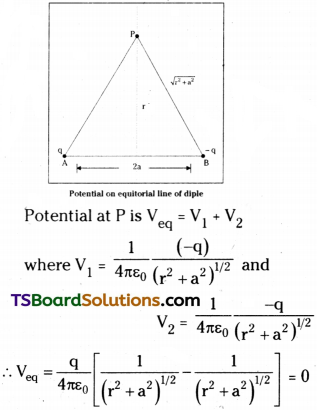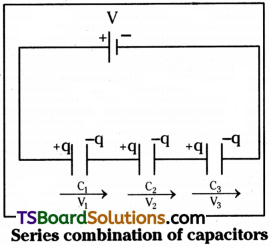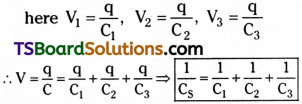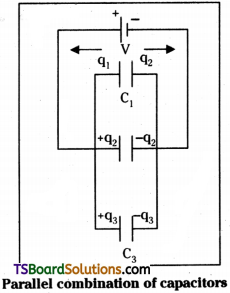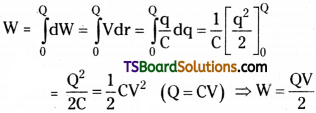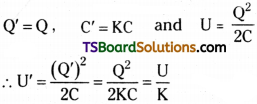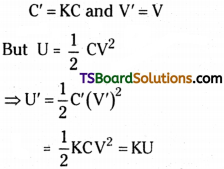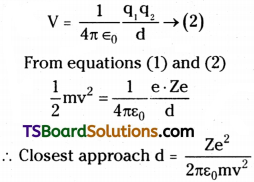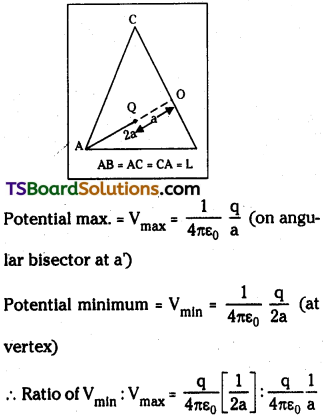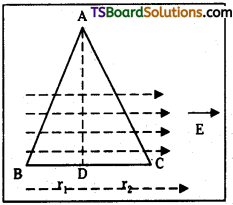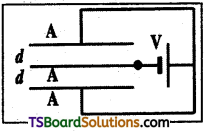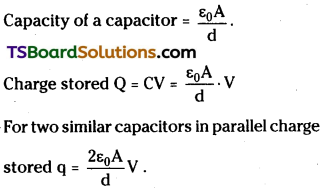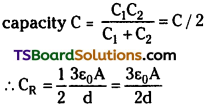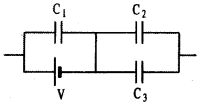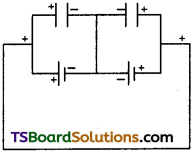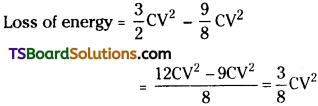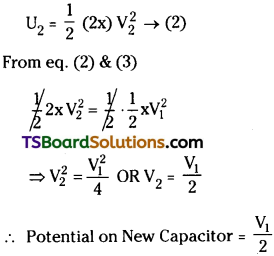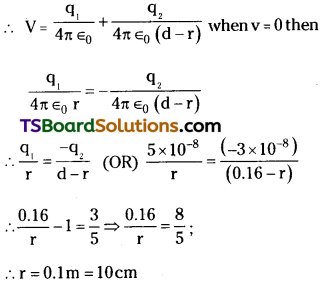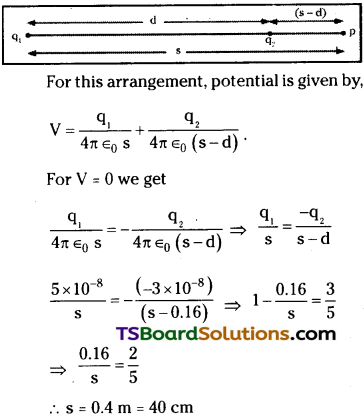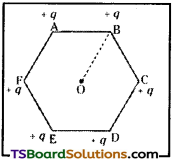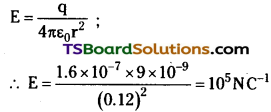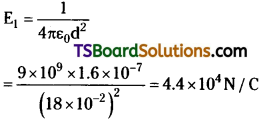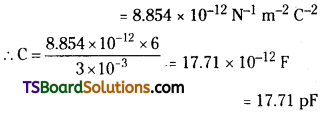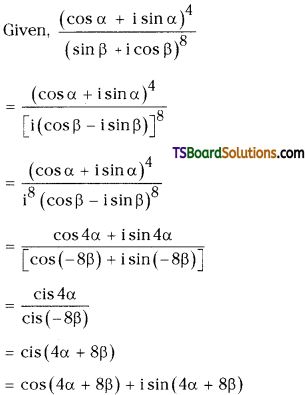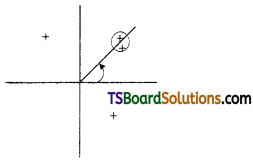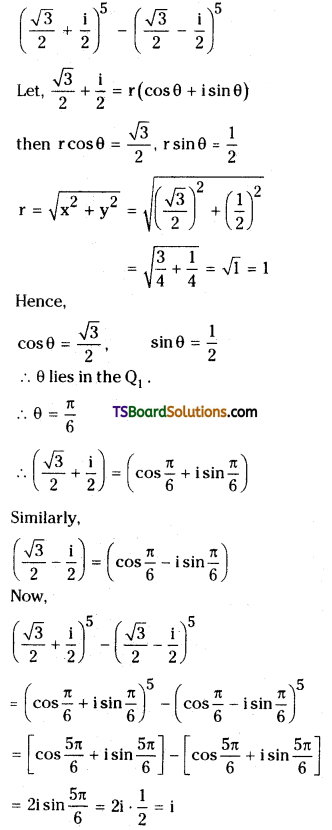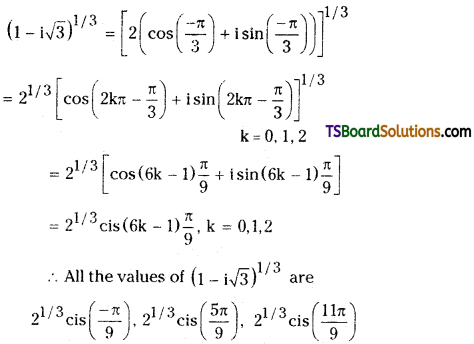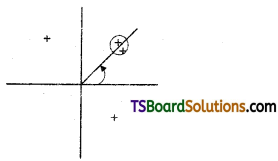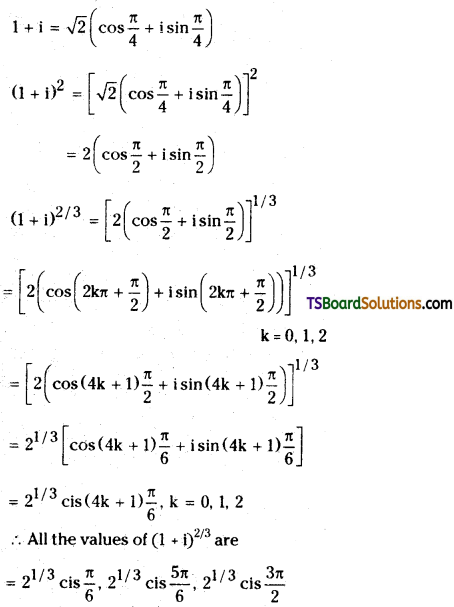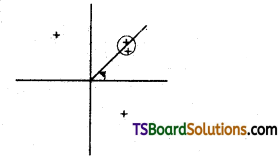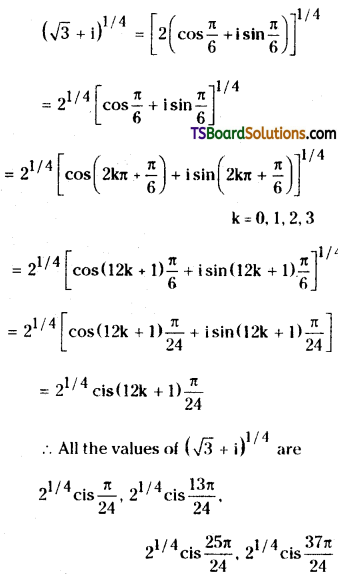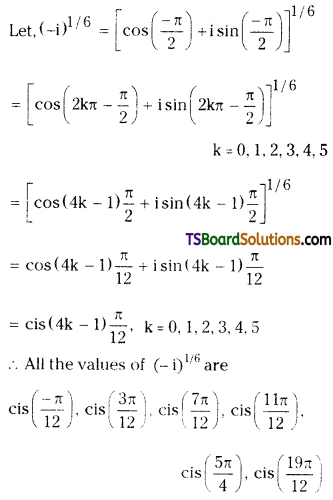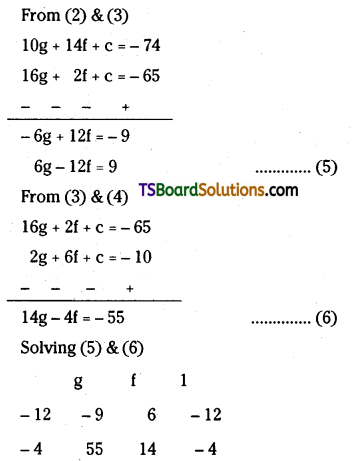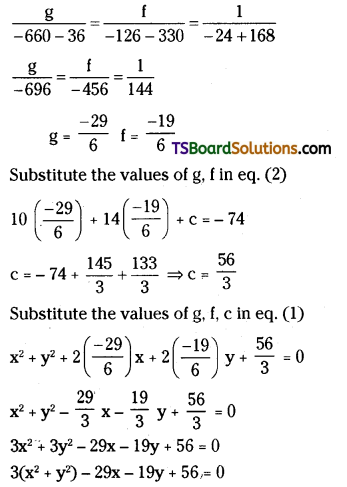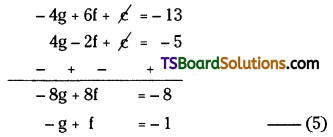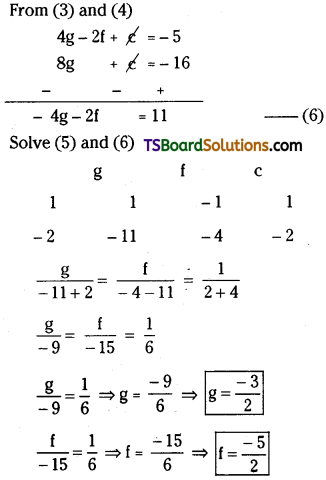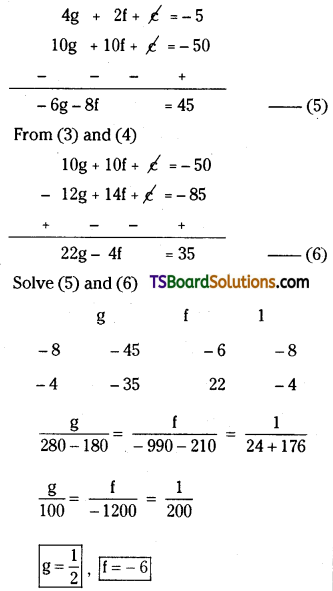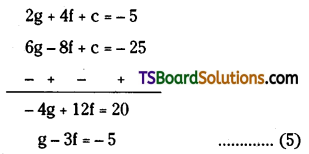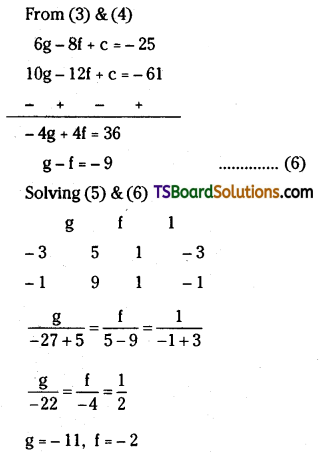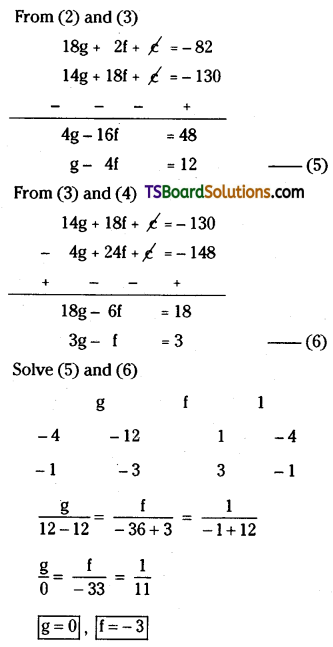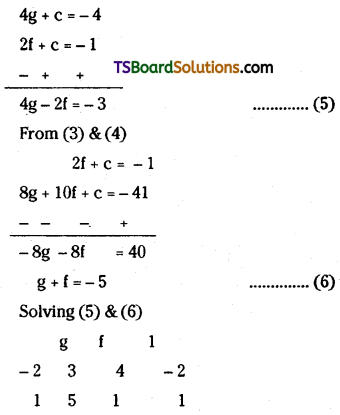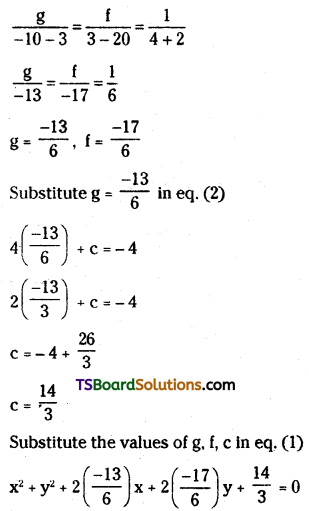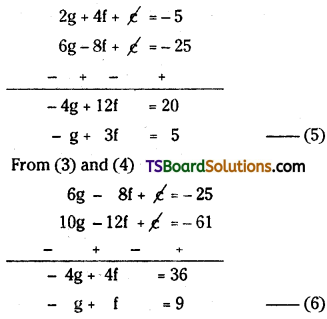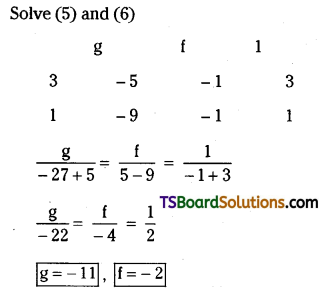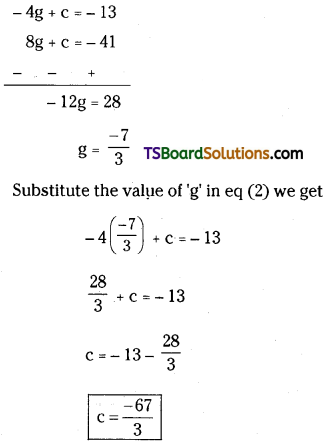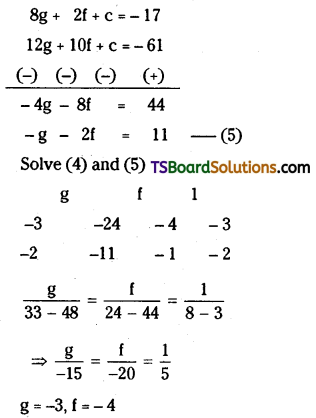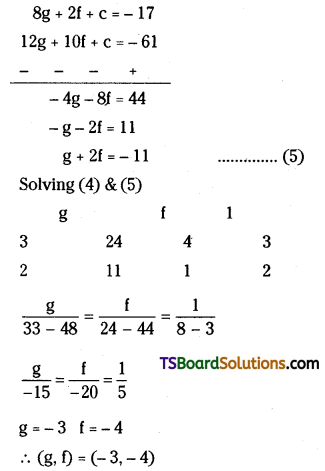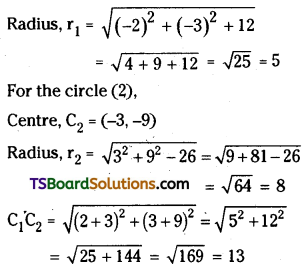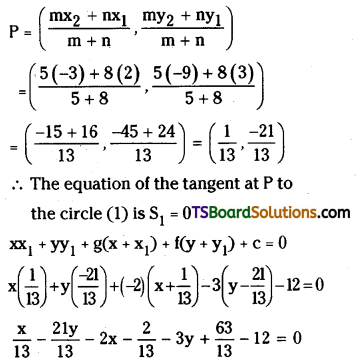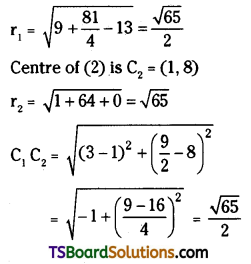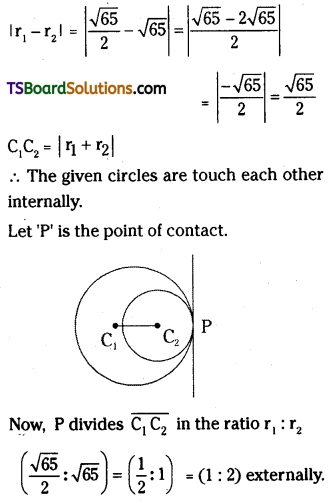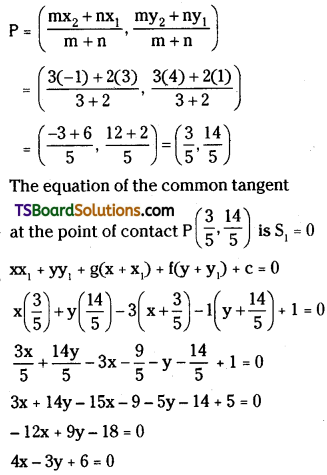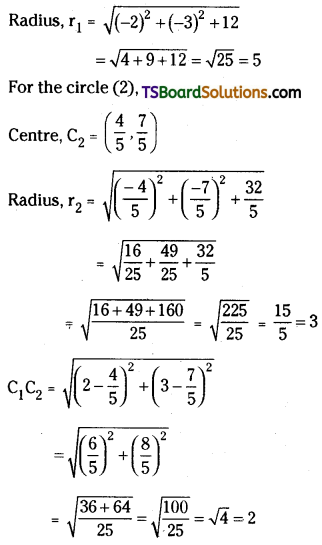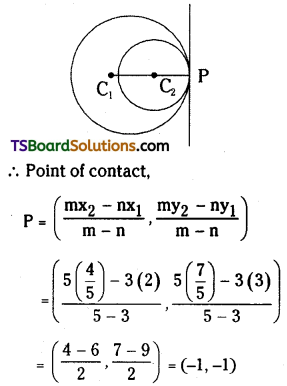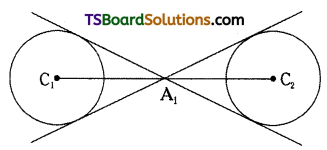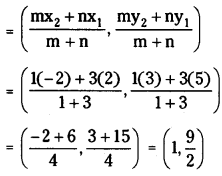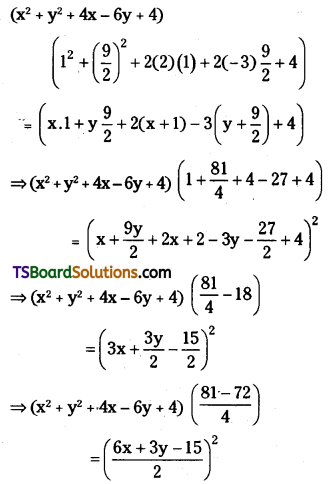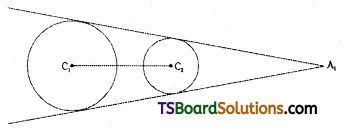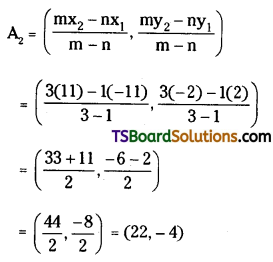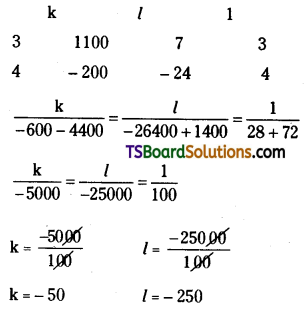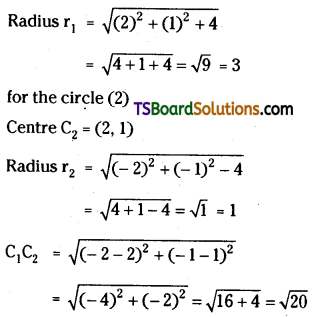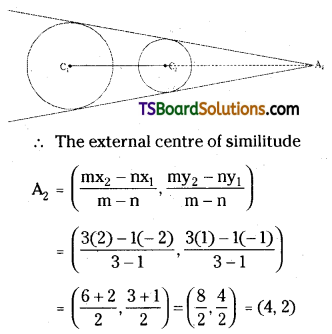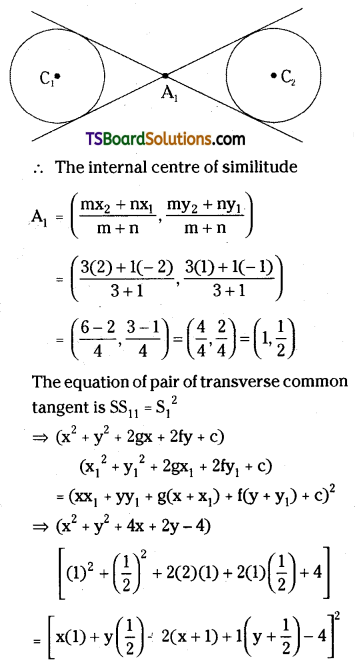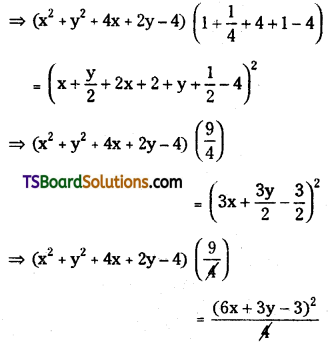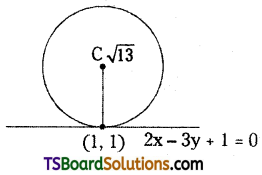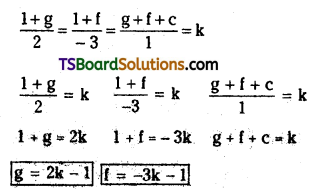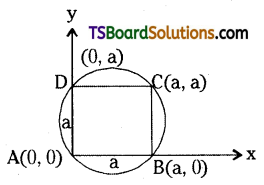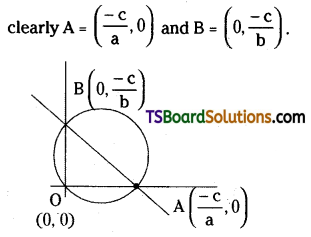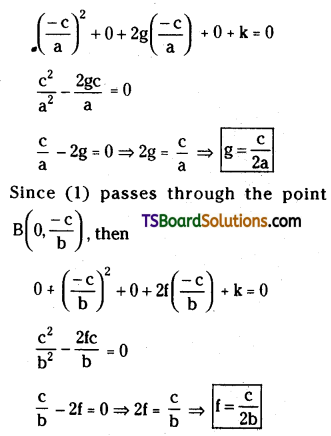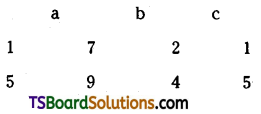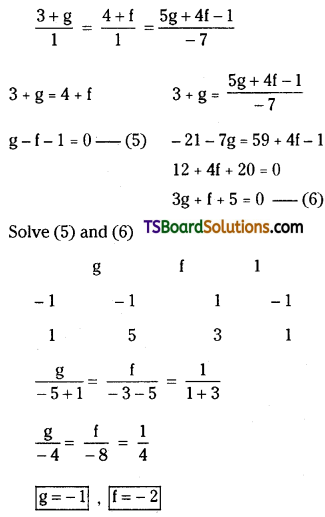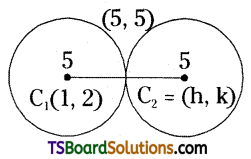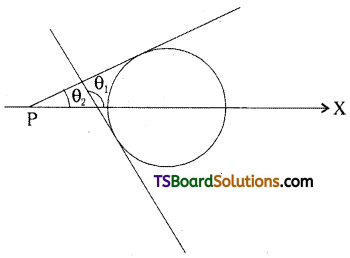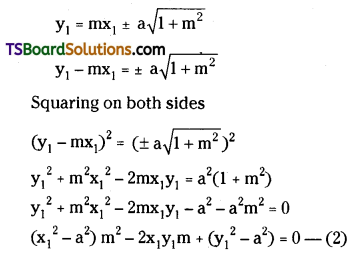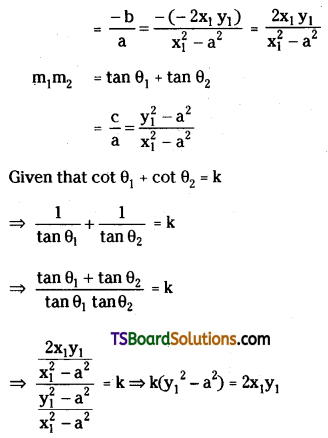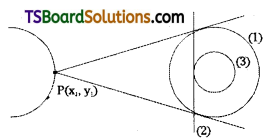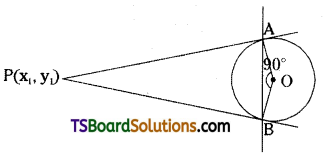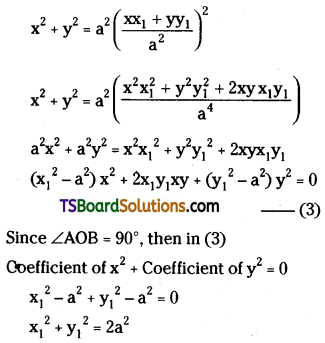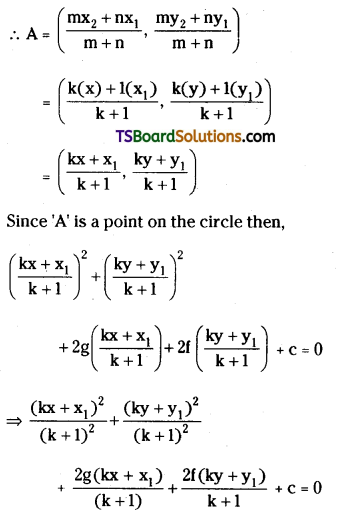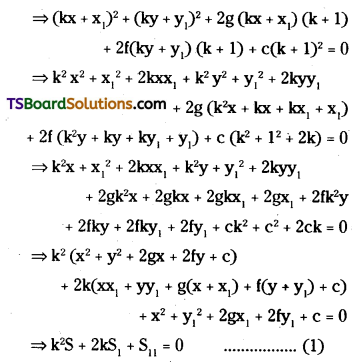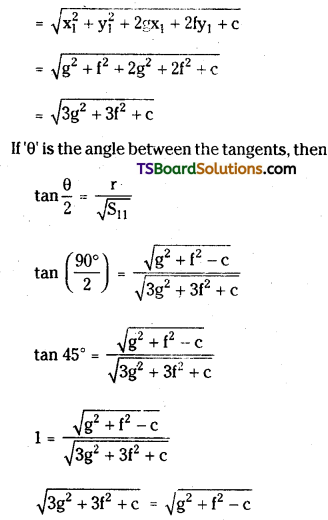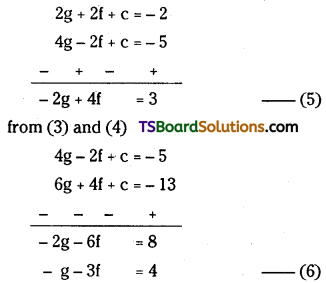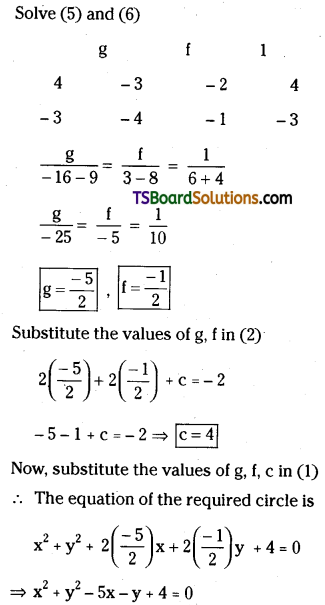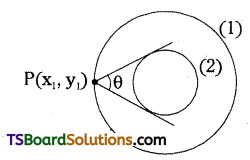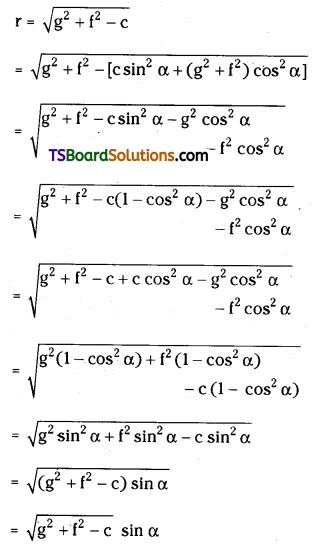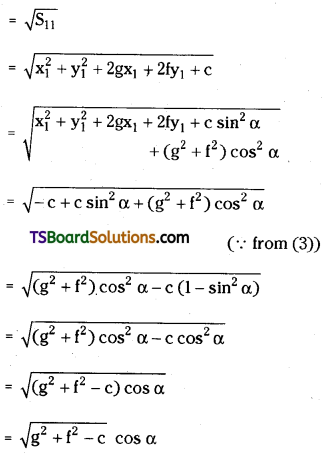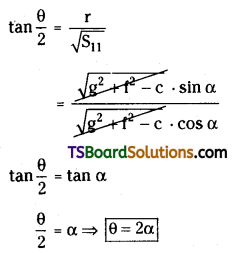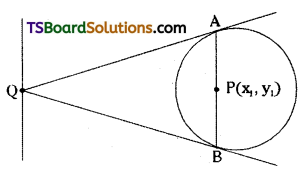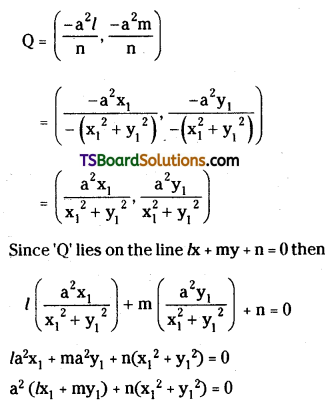Telangana TSBIE TS Inter 2nd Year Physics Study Material 4th Lesson Electric Charges and Fields Textbook Questions and Answers.
TS Inter 2nd Year Physics Study Material 4th Lesson Electric Charges and Fields
Very Short Answer Type Questions
Question 1.
What is meant by the statement ‘charge is quantized’?
Answer:
The minimum charge that can be transferred from one body to another is equal to the charge of an electron ‘e’.
So charge always exists as an integral multiple of charge of electron i.e., Q = ne. (1 e = 1.6 × 10-19 C). Therefore charge in quantized.
Question 2.
Repulsion is the sure test of charging than attraction. Why?
Answer:
A charged body can attract opposite charged body and also a neutral body. But repu¬lsion is only between two charged bodies of same polarity. Hence repulsion is sure test for charging than attraction.
Question 3.
How many electrons constitute 1 C of charge?
Answer:
Chargeq = ne; q = 1 C; e- 1.6 × 10-19 C.

Question 4.
What happens to the weight of a body when it is charged positively?
Answer:
When a body is positively charged it looses electrons, hence its weight decreases (or) it looses weight.

Question 5.
What happens to the force between two charges if the distance between them is a) halved b) doubled?
Answer:
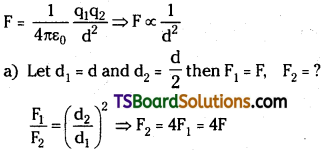
‘F’ increases four times its initial value
b) Let d1 = d and d2 = 2d and F1 = F, F2 = ?

Force between them reduces to 1/4 of initial value.
Question 6.
The electric lines of force do not intersect. Why?
Answer:
The tangent drawn at a point to the line of force gives direction of electric field. If two lines intersect at point of intersection field will be in two different directions, which is not possible. Therefore electric lines of force do not intersect.
Question 7.
Consider two charges + q and – q placed at B and C of an equilateral triangle ABC. For this system, the total charge is zero. But the electric field (intensity) at A which is equidistant from B and C is not zero. Why?
Answer:
Charge is a scalar so total charge Q = q + (- q) = 0. But electric field intensity is a vector and they must be add up vectorially at any given point. So at the point A of equilateral triangle
Question 8.
Electrostatic field lines of force do not form closed loops. If they form closed loops then the work done in moving a charge along a closed path will not be zero. From the above two statements can you guess the nature of electrostatic force?
Answer:
The electrostatic force is conservative force.
Question 9.
State Gauss’s law in electrostatics. Explain its importance. [AP June 15; TS Mar. 15, May 15]
Answer:
Def :
The total electrical flux through any closed surface is equal to \(\frac{1}{\varepsilon_0}\) times the charge enclosed by the surface.

ε0 = permittivity of free space.
Importance :
It is used to find the electric intensity due to various bodies due to charge distributions.
Question 10.
When is the electric flux negative and when is it positive?
Answer:
Electric flux, Φ = \(\overline{\mathrm{E}}.\overline{\mathrm{A}}\) = EA cos θ.
where θ = angle between \(\overline{\mathrm{E}}\) and \(\overline{\mathrm{A}}\).
If 0° < θ ≤ 90°. ⇒ Φ is positive.
When 90° < θ ≤ 180°. ⇒ Φ is negative.
Question 11.
Write the expression for electric intensity due to an infinite long charged wire at a distance radial distance r from the wire.
Answer:
The electric intensity at a point due to an infinitely long charged wire (E) = \(\frac{\lambda}{2 \pi \varepsilon_0 r}\), λ = the linear charge density of the wire.
r = the radial distance of the point from the axis of the wire.
Question 12.
Write the expression for electric intensity due to an infinite plane sheet of charge.
Answer:
The electric intensity due to an infinite plane sheet of charge is, E = \(\frac{\sigma}{2 \varepsilon_0}\), σ – is surface charge density of the sheet.

Question 13.
Write the expression for electric intensity due to a charged conducting spherical shell at points outside and inside the shell.
Answer:
Electric field intensity due to a charged conducting spherical shell
a) At a point outside the shell intensity of electric field E = \(\frac{1}{4 \pi \varepsilon_0} \frac{\mathrm{q}}{\mathrm{r}^2}=\frac{\sigma}{\varepsilon_0} \frac{\mathrm{R}^2}{\mathrm{r}^2}\)
q = σA = σ 4πR²
b) At a point inside the shell intensity of electric field E = 0.
Because potential inside a conducting shell is zero.
Short Answer Questions
Question 1.
State and explain Coulomb’s inverse square law in electricity. [AP May 18, 17; TS Mar. 17, ’14]
Answer:
Coulomb’s Law :
The force of attraction or repulsion between two charges is directly proportional to the product of the two charges and is inversely proportional to square of the distance between them. This force acts along the line joining the two charges.
Explanation:
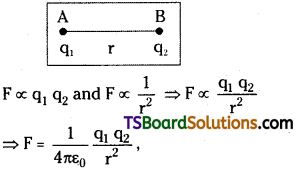
ε0 = permittivity of free space.
ε0 = 8.85 × 10-12Nm²/C²
This electrostatic force between the charges depends on the nature of the medium between them.
In any medium F = \(\frac{1}{4 \pi \varepsilon} \frac{\mathrm{q_1q_2}}{\mathrm{r}^2}\)
ε = permittivity of that medium.
\(\frac{\mathrm{F_{vacuum}}}{\mathrm{F_{med}}}= \frac{\varepsilon}{\varepsilon_0} \) = εr = k
where εr (or) k is called relative permittivity or dielectric constant.
Note :- This force is an action and reaction pair i.e., \(\overline{\mathrm{F}}_{21}=-\overline{\mathrm{F}}_{21}\)
In vector form of Coulomb’s law is

Question 2.
Define intensity of electric field at a point. Derive an expression for the intensity due to a point charge. [AP Mar. ’16]
Answer:
Intensity of electric field: It is defined as the force on a unit positive charge when placed in the electric field.
Proof :-
Consider a point charge ‘Q’ at O’, electric field will exist around that charge.
P = point at a distance r from the charge Q,
q0 = Test charge placed at that point.

Due to a negative charge field is towards it.
Note : The electric field due to a point charge is non-uniform.
Question 3.
Derive the equation for the couple acting on an electric dipole in a uniform electric field. [TS Mar. ’19, May ’18; AP May ’16, ’14]
Answer:
Consider electric dipole of moment ‘p’ in an uniform electric field ‘E’, situated at an angle θ with the field.
The positive charge experiences force “qE” in the direction of field and negative charge experiences as a force – qE opposite to the direction of field. Net force on the dipole is zero. But these two forces will constitute a couple, they will produce torque on the dipole.
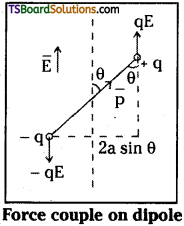
Magnitude of torque (τ) = force × perpendicular distance
= qE (AC) = qE (2a sin θ) = q(2a) E sin θ = pE sin θ
\(\bar{\tau}=\overline{\mathrm{p}} \times \overline{\mathrm{E}}\)
When \(\overline{\mathrm{p}}\) and \(\overline{\mathrm{E}}\) are in the plane of the paper then direction of torque is normal to the plane of paper.
If θ = 90° ⇒ τmax = pE.
The electric dipole moment of a dipole is equal to the torque acting on it when placed in a uniform electric field.

Question 4.
Derive an expression for the intensity of the electric field at a point on the axial line of an electric dipole. [AP Mar. 19, 18, 17, 16, May 16; TS Mar. May 16]
Answer:
Consider an electric dipole with charges q, – q with separation ‘2a’ between them.
Let p = a point on its axial line at a distance r from the mid point of the dipole
Eaxial = intensity of electric field at p
Eaxial = E+q + E-q.
The electric field at p due to the charge + q
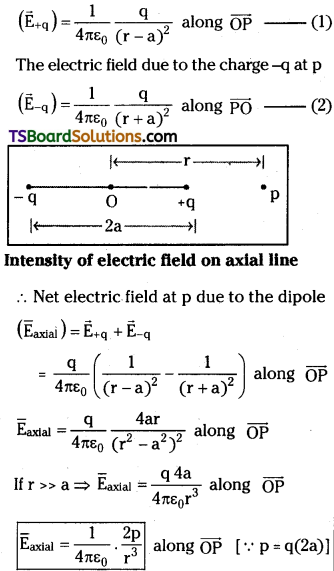
Question 5.
Derive an expression for the intensity of the electric field at a point on the equatorial plane of an electric dipole.
Answer:
Consider an electric dipole with charges q, -q with a separation ‘2a’ between them. Consider a point p’ on the equatorial of the dipole at a distance r from the centre of the dipole. Electric field at p is the resultant of E+q and E-q.
The electric field due to the charge +q at p
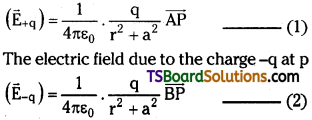
These are equal in magnitude. The components of E+q and E-q normal to the axis of the dipole cancel each other, the components along the axis will add up.
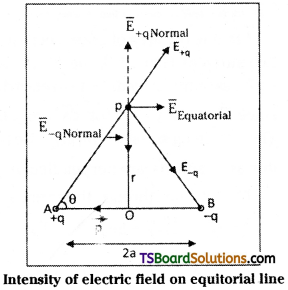
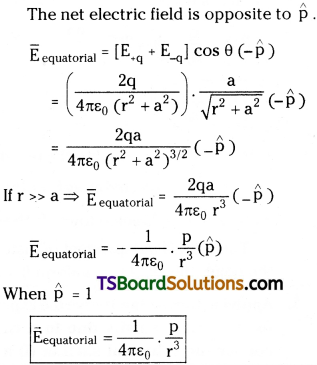
Question 6.
State Gauss’s law in electrostatics and explain its importance. [TS Mar. ’ 18,’ 15, May ‘ 17; AF June 15, Mar. 15]
Answer:
Gauss’s Law :
The total electric flux through any closed surface is equal to \(\frac{1}{\varepsilon_0}\) times the net charge enclosed by the surface.

where ε0 = permittivity of free space,
q = total cherge enclosed by the surface.
Importance:
- Using Gauss law we can find field due to a distribution of charge.
- Gauss’s law is often useful towards a much easier calculation of the electrostatic field when the system has symmetry.
Long Answer Questions
Question 1.
Define electric flux. Applying Gauss’s law and derive the expression for electric intensity due to an infinite long straight charged wire. (Assume that the electric field is everywhere radial and depends only on the radial distance r of the point from the wire.)
Answer:
Electric flux :
The number of electric lines of force passing normally through a given surface is called “electric flux” (Φ).
Expression for electric intensity :
Let us consider an infinitely long thin straight wire having linear charge density λ. (∵ λ= Q/L)
Consider a cylindrical Gaussian surface ABCD of length ‘l’ and radial distance r. The electric field \(\overline{\mathrm{E}}\) is radial and which perpendicular to the length of the wire.
The flux through the flat surfaces AB and CD are zero. (∵ \(\overrightarrow{E}\) ⊥ \(\overrightarrow{A}\))
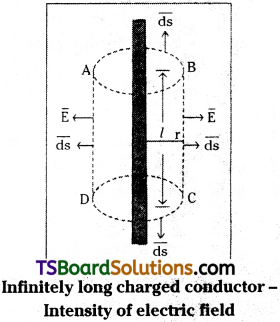
The flux through the curved surface ABCD is given by
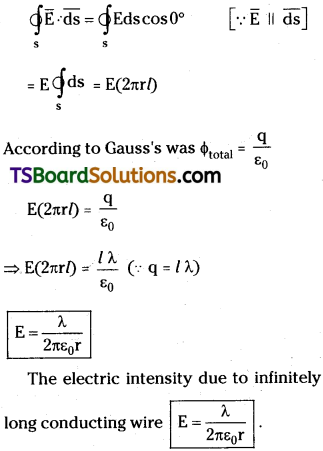
λ is positive ⇒ direction will be radially outwards
λ is negative ⇒ direction will be radially inwards 2
Question 2.
State Gauss’s law in electrostatics. Applying Gauss’s law derive the expression for electric intensity due to an infinite plane sheet of charge.
Answer:
Gauss’s law :
The total electrical flux through any closed surface is equal to 1/ε0 times the net charge enclosed by that surface.
Expression for electric intensity:

Consider an infinite plane sheet ABCD of uniform surface charge density ‘σ’.
Surface charge density

Take a Gaussian surface in the form of a rectangular parallelopiped.
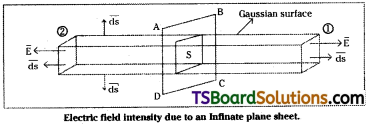
Assume the area of cross section of the two surfaces (1) and (2) be ‘S’. These two surfaces only will contribute to electric flux, since \(\overrightarrow{E}\) and area vector \(\overrightarrow{ds}\) are parallel. The remaining surfaces will give rise to zero flux as \(\overrightarrow{E}\) and \(\overrightarrow{ds}\) are perpendicular.
The total flux through the surface
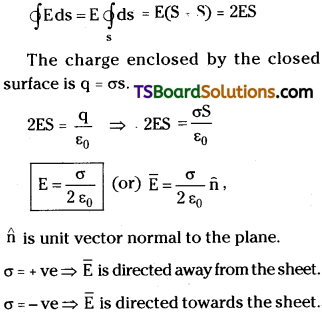
This field is independent of distance of the point, this field is a uniform field.
Question 3.
Applying Gauss’s law derive the expression for electric intensity due to a charged conducting spherical shell at (i) a point outside the shell (ii) a point on the surface of the shell and (iu) a point inside the shell.
Answer:
Consider a charged spherical shell of radius R and of uniform surface charge density σ.

1) Field out side the shell:
Consider a point P outside the shell with a radius vector \(\overrightarrow{r}\). (\(\overrightarrow{r}\) > \(\overrightarrow{R}\))
Now consider a Gaussian surface which is spherical of radius r.
As all the points on this surface are at same distance.
The flux through the Gaussian surface
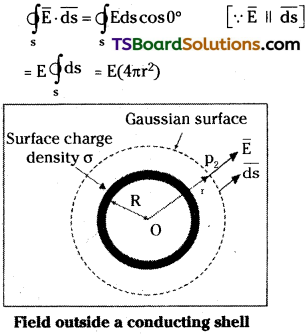
The charge enclosed by the
Gaussian surface is q = σ.(4πr²)
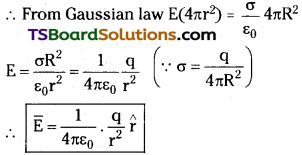
2) Field at a point on the shell:
If the point lies on the surface of the shell
⇒ r = R.
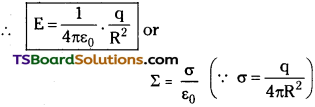
3) Field at a point inside the shell:
Consider a spherical Gaussian surface passing through P inside the shell with centre as ’O’.
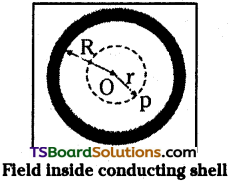
The flux through this surface is

But the there is no charge enclosed by the surface i.e., q = 0.

∴ The field inside a uniformly charged thin shell at all points inside is zero.
Intext Question and Answer
Question 1.
Two small identical balls, each of mass 0.20 g, carry identical charges and are suspended by two threads of equal lengths. The balls position themselves at equilibrium such that the angle between the threads is 60°. If the distance between the balls is 0.5m, find the charge on each ball.
Answer:
Mass of each ball = 0.20g = 20 × 10-4kg
Angle between them θ = 60°
Separation between balls = 0.5m
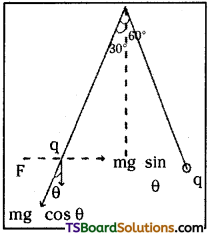
At equilibrium
Electrostatic force F is
balanced by component of weight mg sin θ.
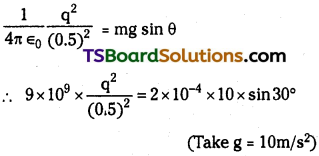
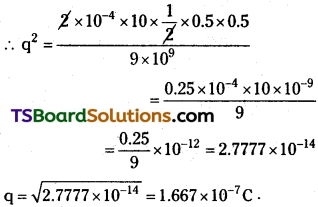
Question 2.
An infinite number of charges each of magnitude q are placed on x – axis at distances of 1, 2, 4,8, …………. meter from the origin respectively. Find intensity of the electric field at origin.
Answer:
The charges are as shown.
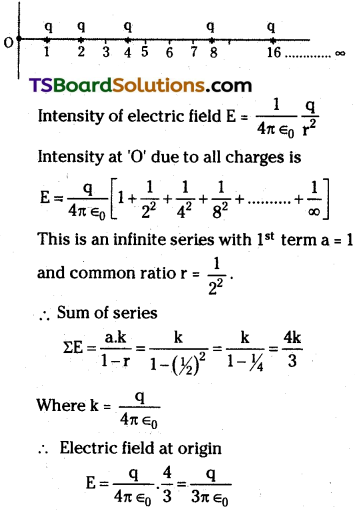
Question 3.
A clock face has negative charges-q, -2q, -3q, …….. – 12q fixed at the position of the corresponding numberals on the dial. The clock hands do not disturb the net field due to the point charges. At what time does the hour, hand point in the direction of the electric field at the centre of the dial?
Answer:
Negative charges are arranged on the clock as shown.

Charge arrangement
Electric field due to – q = \(\frac{1}{4 \pi \varepsilon_0} \frac{\mathrm{q}}{\mathrm{r}^2}\) = say k
Where r is distance from centre ‘O’ to the numbers on dial
Field due to- 2q = 2k; due to -3q = 3k ……….. Field due to -12q = 12k
Electric field is directed as shown in figure.
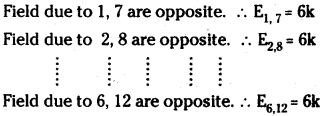
They are as shown in figure.
Consider E7 and E9 magnitude of each = 6k angle between them is 60°.
∴ Resultant of E7 & E9 is along E8.
Magnitude is
\(\sqrt{6 \mathrm{k}^2+6 \mathrm{k}^2+2 \times 6 \mathrm{k} \times 6 \mathrm{k} \times \cos \theta}\) say x.
Field along E8 = 6k + x …………. (1)
Consider E10 and E12 their magnitudes are 6k and 6k angle between them is 60°.
Resultant of E10, E12 is along E11.
Resultant field along
E11 = \(\sqrt{6 \mathrm{k}^2+6 \mathrm{k}^2+2 \times 6 \mathrm{k} \times 6 \mathrm{k} \cdot \cos 60^{\circ}}\) say y.
Now x, y are equal.
Total field along E11 = 6k + y ……….. (2)
From eq 1, 2 magnitudes of E8, E11 are equal and angle between them is 90°.
∴ Angle of resultant θ = 45° with E8.
In clock Anglb between each digit say 8 & 9 = 30°
9 & 10 = 30° i.e., 1 hour corresponds to 30° angle so angle 45° ⇒ 1\(\frac{1}{2}\) hour
Direction of resultant field = 8 + 1\(\frac{1}{2}\) = 9\(\frac{1}{2}\) hours = 9 hours 30 minutes.

Question 4.
Consider a uniform electric field E = 3 × 10³ N/C. (a) What is the flux of this field through a square of 10 cm on aside whose plane is parallel to the yz plane? (b) What is the flux through the same square if the normal to its plane makes a 60° angle with the x – axis?
Answer:
Intensity of electric field E = 3 × 10³ N/C along x-axis.
Area of Square = 1² = 10 × 10 = 100 cm²
= 100 × 10-4 m² = 10-2m²
(a) When plane of square is parallel to y – z plane it is perpendicular to x-axis
⇒ 0 = 90°
∴ Flux through square Φ = \(\overline{\mathrm{E}}.\overline{\mathrm{A}}\) (or)
Φ = EA cos θ
Φ = 3 × 10³ × 10-2 = 3 × 10 = 30 vm
(b) When square makes an angle θ = 60°
with x- axis, θ =60°.
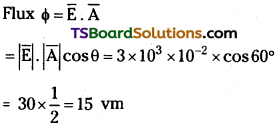
Question 5.
There are four charges, each with a magnitude Q. Two are positive and two are negative. The charges are fixed to the corners of a square of side ‘L’, one to each corner, in such a way that the force on any charge is directed toward the center of the square. Find the magnitude of the net electric force experienced by any charge?
Answer:
Given two charges are +ve and two charges are -ve.
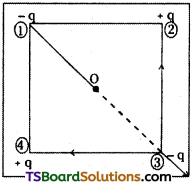
Force on any charge is directed towards centre.
Side of square = L at point 3
Consider charge 3 total forces on it are
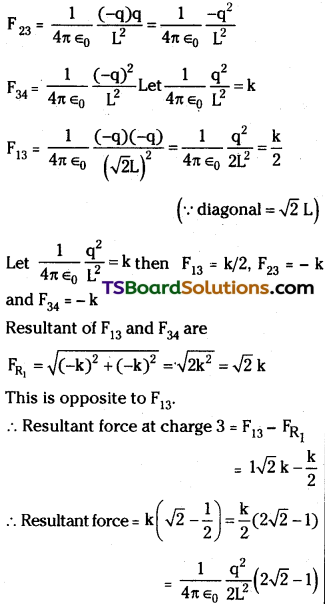
Question 6.
The electric field in a region is given by \(\overrightarrow{\mathbf{E}}=\mathbf{a} \hat{\mathbf{i}}+\mathbf{b} \hat{\mathbf{j}}\). Here a and b are constants. Find the net flux passing through a square area of side L parallel to y – z plane.
Answer:
Electric field \(\overrightarrow{\mathbf{E}}=\mathbf{a} \hat{\mathbf{i}}+\mathbf{b} \hat{\mathbf{j}}\)
Side of square = L
∴ Area of square = L²
Give square is parallel to y – z plane ⇒ it is perpendicular x – axis ⇒ Area vector
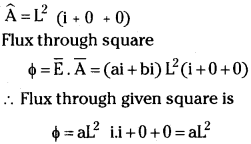
Question 7.
A hollow spherical shell of radius r has a uniform charge density σ. It is kept in a cube of edge 3r such that the center of the cube coincides with the center of the shell. Calculate the electric flux that comes out of a face of the cube.
Answer:
(Charge density on sphere = σ. But σ = \(\frac{Q}{A}\)
Area of spere A = 4πr²
⇒ Charge Q = 4πr²σ
For a point out side the sphere it seems to be concentrated at centre.
∴ Charge at centre of cube Q = 4πr²σ)
From gauss’s law total flux comming out of
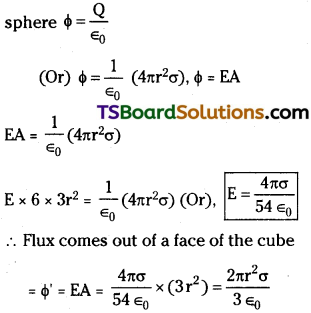
Question 8.
An electric dipole consists of two equal and opposite point charges + Q and – Q, separated by a distance 2l. P is a point collinear with the charges such that is distance from the positive charge is half of its distance from the negative charge.
Answer:
Each charge on dipole = q, -q
Separation between charges = 2l
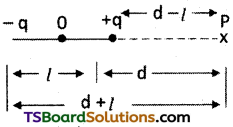
P is on the line joining the charges ⇒ it is on axial line.
Given : distance from +ve’ charge = \(\frac{1}{2}\) distance from -ve’ charge.
From given data d – l = \(\frac{1}{2}\) ( d + l) ⇒ 2d – 2l = d + l (or) d = 3l
Intensity of electric field at any point on
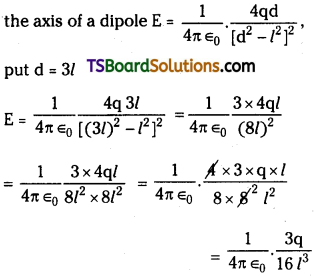
Question 9.
Two infinitely long thin straight wires having uniform linear charge densities λ and 2λ are arranged parallel to each other at a distance r apart. The intensity of the electric field at a point midway between them is
Answer:
Charge densities of infinitely long conductors = λ and 2λ
Distance between conductors = r
Intensity of electric field of mid point = ?
For mid point distance d = r/2
Intensity of electric field due to a long conductor.
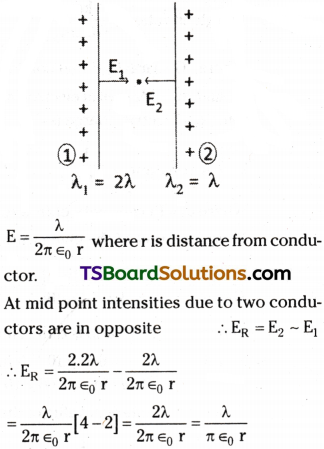
Question 10.
Two infinitely long thin straight wires having uniform linear charge densities \(\ddot{\mathrm{e}}\) and 2\(\ddot{\mathrm{e}}\) are arranged parallel to each other at a distance r apart. The intensity of the electric field at a point midway between them is
Answer:
Linear charge densities σ1 = σ2 and σ2 = 2e.
Separation between two parallel conductors d = r
For mid-way between them d = r/2
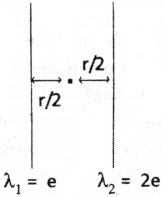
At midpoint intensities are in oppisite direction so resultant intensity ER = E1 ~ E2
Intensity of electric field from an infinitely long charged conductor E = \(\frac{\lambda}{2 \pi \varepsilon_0r}\)
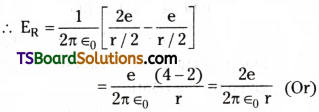
Intensity of electric field at mid point E = \(\frac{e}{\pi \varepsilon_0r}\)

Question 11.
An electron of mass m and chargee is fired perpendicular to a uniform electric field of intensity E with an initial velocity u. If the electron traverses a distance x in the field in the direction of firing. Find the transverse displacement y it suffers.
Answer:
Mass of electron = m ;
Charge on electron = e
Intensity of electric field = E
∴ Force F = E . e
Initial velocity of electron = u; acceleration of electron a = F/m = E.e/m
Distance travelled S = x. along x-axis
⇒ time t = \(\frac{x}{4}\) …………. (1)
Distance travelled along y-axis = ?
Initial velocity along y-axis = u = 0
Vertical displacement y = ut + \(\frac{1}{2}\) at² = \(\frac{1}{2}\)at²
⇒ y = \(\frac{1}{2}\frac{Ee}{m}.\frac{x}{u^2}\)
∴ Vertical displacement after travelling a eEx2 distance x is y = \(\frac{eEx^2}{2mu^2}\)
Additional Exercises
Question 1.
What is the force between two small charged spheres having charges of 2 × 10-7 C and 3 × 10-7 C placed 30 cm apart in air?
Answer:
Repulsive force of magnitude 6 × 10-3 N ;
Charge on the first sphere, q: = 2 × 10-7
C Charge on the second sphere, q² = 3 × 10-7 C ;
Distance between the spheres, r = 30 cm = 0.3 m
Electrostatic force between the spheres is given by the relation,
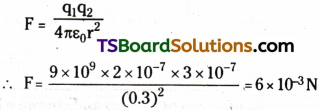
Hence, force between the two small charged spheres is 6 × 10-3 N. The charges are of same nature. Hence, force between them will be repulsive.
Question 2.
The electrostatic force on a small sphere of charge 0.4 µC due to another small sphere of charge – 0.8 µC in air is 0.2 N. (a) What is the distance between the two spheres? (b) What is the force on the second sphere due to the first?
Answer:
a) Electrostatic force on the first sphere, F = 0.2 N
Charge on this sphere, = 0.4 µC
= 0.4 × 10-6 C
Charge on the second sphere,
q2 = -0.8 µC = -0.8 × 10-6
Electrostatic force between the spheres

The distance between the two spheres is 0.12 m.
b) Both the spheres attract each other with the same force. Therefore, the force on the second sphere due to the first is 0.2 N.

Question 3.
Check that the ratio ke²/G memp is dimensionless. Look up a Table of Physical Constants and determine the value of this ratio. What does the ratio signify?
Answer:
1) The given ratio is \(\frac{\mathrm{ke^2}}{\mathrm{Gm_em_p}}\)
Where, G = Gravitational constant
me and mp = Masses of electron and proton.; e = Electric charge is C.
k = A constant. = \(\frac{1}{4 \pi \varepsilon_0}\),
Where ε0 = Permittivity of free space
Therefore, unit of the given ratio

Hence, the given ratio is dimensionless,
ii) e = 1.6 × 10-19C; G = 6.67 × 10-11 N m²kg-2; me = 9.1 × 10-31 kg ; mp = 1.66 × 10-27kg
Hence, the numerical value of the given ratio is
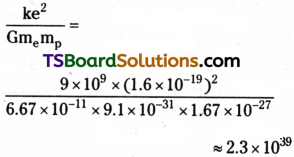
This is the ratio of electric force to the gravitational force between a proton and an electron, keeping distance between them constant.
Question 4.
a) Explain the meaning of the statement ‘electric charge of a body is quantised’.
b) Why can one ignore quantisation of electric charge when dealing with macroscopic i.e., large scale charges?
Answer:
a) Electric charge of a body is quantized. This means that only integral (1, 2, …………, n) number of electrons can be transferred from one body to the other. Charges are not transferred in fraction. Hence, a body possesses total charge only in integral multiples of electric charge.
b) In macroscopic or large scale charges, the charges used are huge as compared to the magnitude of electric charge. Hence, quantization of electric charge is of no use on macroscopic scale. Therefore, it is ignored and it is considered that electric charge is continuous.
Question 5.
Four point charges qA = 2 µC, qB = – 5µC, qC = 2 µC, and qD = – 5 µC are located at thecomereofasquare ABCD of side 10cm. What is the force on a charge of 1 µC placed at the centre of the square?
Answer:
The given figure shows a square of side 10 cm with four charges placed at its corners. O is the centre of the square.
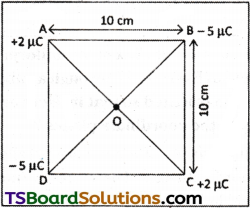
Where, (Sides) AB = BC = CD = AD = 10 cm
(Diagonals) AC = BD = 10√2 cm
AO = OC = DO = OB = 5√2 cm
A charge of amount 1 µC is placed at point O.
Force of repulsion between charges placed at corner A and centre O is equal in magnitude but opposite in direction relative to the force of repulsion between the charges placed at corner C and centre O. Hence, they will cancel each other. Similarly, force of attraction between charges placed at corner B and centre O is equal in magnitude but opposite in direction relative to the force of attraction between the charges placed at corner D and centre O. Hence, they will also cancel each other. Therefore, net force caused by the four charges placed at the corner of the square on 1 µC charge at centre O is zero.

Question6.
a) An electrostatic field line is a continuous curve. That is, a field line cannot have sudden breaks. Why not?
b) Explain why two field lines never cross each other at any point?
Answer:
a) An electrostatic field line is a continuous curve because a charge experiences a continuous force when traced in an electrostatic field. The field line cannot have sudden breaks because the charge moves continuously and does not jump from one point to the other.
b) If two field lines cross each other at a point, then electric field intensity will show two directions at that point. This is not possible. Hence, two field lines never crosr. each other.
Question 7.
An electric dipole with dipole moment 4 × 10-9 C m is aligned at 30° with the direction of a uniform electric field of magnitude 5 × 104 N C-1. Calculate the magnitude of the torque acting on the dipole.
Answer:
Electric dipole moment, p = 4 × 10-9 C m ;
Electric field, E = 5 × 104 N C-1
Angle made by p with a uniform electric field, θ = 30°
Torque acting on the dipole is given by the relation, τ = pE sin θ
= 4 × 10-9 × 5 × 104 × sin 30
= 20 × 10-5 × 1/2 = 10-4 Nm
Therefore, the magnitude of the torque acting on the dipole is 10-4 N m.
Question 8.
a) Two insulated charged copper spheres A and B have their centers separated by a distance of 50 cm. What is the mutual force of electrostatic repulsion if the charge on each is 6.5 × 10-7 C? The radii of A and B are negligible compared to the distance of separation.
b) What is the force of repulsion if each sphere is charged double the above amount, and the distance between them is halved?
Answer:
a) Charge on sphere A, qA = Charge on sphere B, qB = 6.5 × 10-7 C
Distance between the spheres,
r = 50 cm = 0.5 m
Force of repulsion between the two
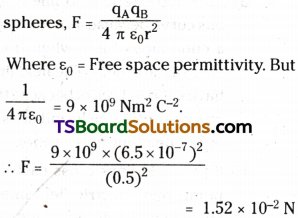
Therefore, the force between the two spheres is 1.52 × 10-2 N.
b) After doubling the charge, charge on sphere A, qA = Charge on sphere B,
qB = 2 x 6.5 × 10-7C = 1.3 × 10-6C
The distance between the spheres is halved.
∴ r = \(\frac{0.5}{2}\) = 0.25 m
Force of repulsion between the two spheres,
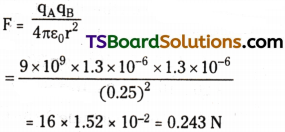
Therefore, the force between the two spheres is 0.243 N.
Question 9.
Figure shows tracks of three charged particles in a uniform electrostatic field. Give the signs of the three charges. Which particle has the highest charge to mass ratio?

Answer:
Opposite charges attract each other and same charges repel each other. It can be observed that particles 1 and 2 both move towards the positively charged plate and repel away from the negatively chargee plate. Hence, these two particles are negatively charged. It can also be observed that particle 3 moves towards the negatively charged plate and repels away from the positively charged plate. Hence, particle 3 is positively charged.
The charge to mass ratio (emf) is directly proportional to the displacement or amount of deflection for a given velocity. Since the deflection of particle 3 is the maximum, it has the highest charge to mass ratio.
Question 10.
What is the net flux of the uniform electric field of Exercise 15 through a cube of side 20 cm oriented so that its faces are parallel to the coordinate planes?
Answer:
All the faces of a cube are parallel to the coordinate axes. Therefore, the number of field lines entering the cube is equal to the number of field lines piercing out of the cube. As a result, net flux through the cube is zero.

Question 11.
Careful measurement of the electric field at the surface of a black box indicates that the net outward flux through the surface of the box is 8.0 × 10³ N m²/C.
a) What is the net charge inside the box?
b) If the net outward flux through the surface of the box were zero, could you conclude that there were no charges inside the box? Why or Why not?
Answer:
a) Net outward flux through the surface of the box, Φ = 8.0 × 10³ N m²/C
For a body containing net charge q, flux is given by the relation, Φ = \(\frac{q}{\varepsilon_0}\)
ε0 = Permittivity of free space = 8.854 × 10-12 N-1C²m-2
q = ε0Φ = 8.854 × 10-12 × 8.0 × 10³
= 7.08 × 10-8 = 0.07 µC
Therefore, the net charge inside the box is 0.07 µC.
b) No
Net flux piercing out through a body depends on the net charge contained in the body. If net flux is zero, then it can be inferred that net charge inside the body is zero. The body may have equal amount of positive and negative charges.
Question 12.
A point charge + 10 µC is a distance 5 cm directly above the centre of a square of side 10 cm, as shown in Figure. What is the magnitude of the electric flux through the square? (Hint: Think of the square as one face of a cube with edge 10 cm.)
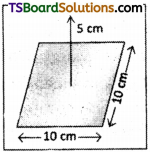
Answer:
The square can be considered as one face of a cube of edge 10 cm with a centre where charge q is placed. According to Gauss’s theorem for a cube, total electric flux is through all its six faces.
Hence, electric flux through one face of the cube
Φtotal = \(\frac{q}{\varepsilon_0}\)
Hence, electric flux through one fact of the cube i.e., through the square,
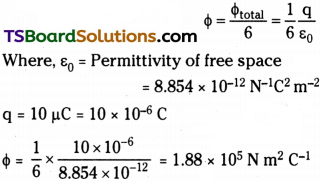
Therefore, electric flux through the square is 1.88 × 105 Nm²C-1
Question 13.
A point charge of 2.0 µC is at the centre of a cubic Gaussian surface 9.0 cm on edge. What is the net electric flux through the surface?
Answer:
Net electric flux (Φnet) through the cubic surface is given by, Φnet = \(\frac{q}{\varepsilon_0}\)
Where, ε0 = Permittivity of free space = 8.854 × 10-12N-1C²m-2
q = Net charge contained inside the cube = 2.0 µC = 2 × 10-6 C

The net electric flux through the surface is 2.26 × 105 Nm²C-1.
Question 14.
A point charge causes an electric flux of -1.0 × 10³ Nm²/C to pass through a sphe¬rical Gaussian surface of 10.0 cm radius centered on the charge.
a) If the radius of the Gaussian surface were doubled, how much flux would pass through the surface?
b) What is the value of the point charge?
Answer:
a) Electric flux, Φ = -1.0 × 10³ Nm²/C ;
Radius of the Gaussian surface, r = 10.0 cm
Electric flux piercing out through a surface depends on the net charge enclosed inside a body. It does not depend on the size of the body. If the radius of the Gaussian surface is doubled, then the flux passing through the surface remains the same i.e., – 10³ N m²/C.
b) Electric flux is given by the relation, Φ = \(\frac{q}{\varepsilon_0}\)
Where, q = Net charge enclosed by the spherical surface
ε0 = Permittivity of free space
= 8.854 × 10-12 N-1C²m-2
∴ q = Φε0 = – 1.0 × 10³ × 8.854 × 10-12
= – 8.854 × 10-9 C = – 8.854 nC
Therefore, the value of the point charge is-8.854 nC.
Question 15.
A conducting sphere of radius 10 cm has an unknown charge. If the electric field 20 cm from the centre of the sphere is 1.5 × 10³ N/C and points radially inward, what is the net charge on the sphere?
Answer:
Electric field intensity (E) at a distance (d) from the centre of a sphere containing net charge q is given by the relation,
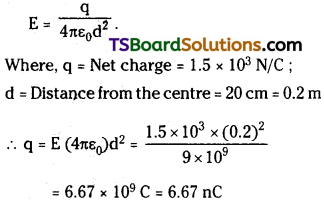
Therefore, the net charge on the sphere is 6.67 nC.
Question 16.
A uniformly charged conducting sphere of 2.4 m diameter has a surface charge density of 80.0 µC/m².
a) Find the charge on the sphere.
b) What is the total electric flux leaving the surface of the sphere?
Answer:
a) Diameter of the sphere, d = 2.4 m ;
Radius of the sphere, r = 1.2 m
Surface charge density σ = 80.0 µC/m²
= 80 × 10-6C/m²
Total charge on the surface of the sphere,
Q = Charge density × Surface area
Q = σ × 4πr² = 80 × 10-6 × 4 × 3.14 × (1.2)²
= 1.447 × 10-3C
Therefore, the charge on the sphere is 1.447 × 10-3 C.
b) Total electric flux (Φtotal) leaving out the surface of a sphere containing net charge
Q is given by the relation, Φtotal = \(\frac{Q}{\varepsilon_0}\)

Therefore, the total electric flux leaving the surface of the sphere is 1.63 × 10-8NC-1m²

Question 17.
An infinite line charge produces a field of 9 × 104 N/C at a distance of 2 cm. Calculate the linear charge density.
Answer:
Electric field produced by the infinite line charges at a distance d having linear charge density λ is given by the relation,
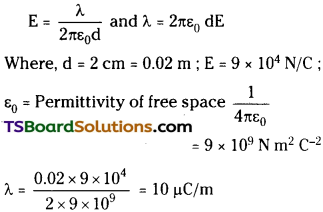
Therefore, the linear charge density is 10 µC/m
![]()
![]()
